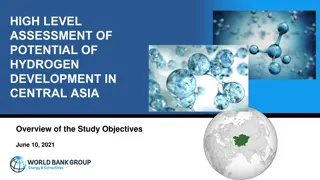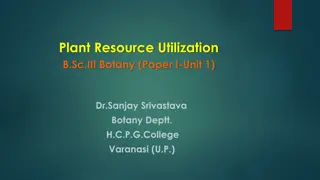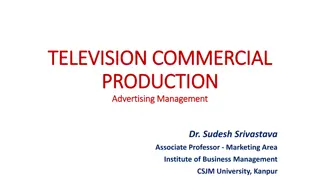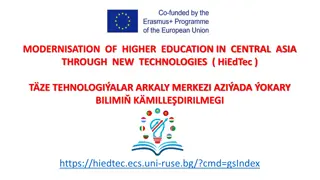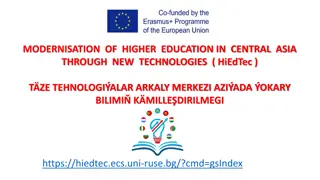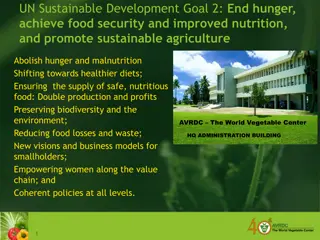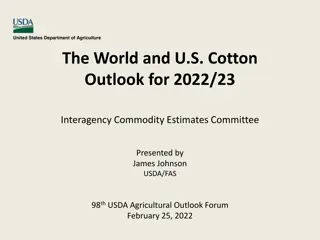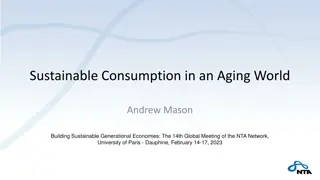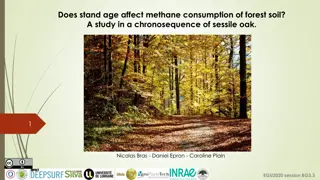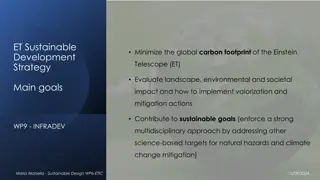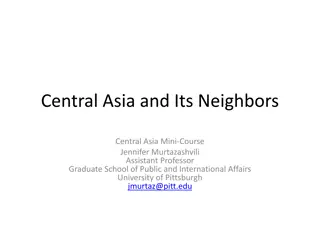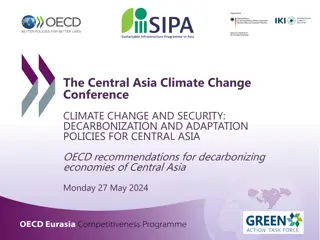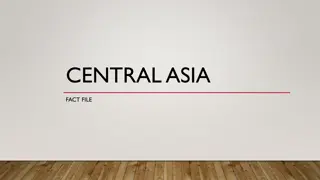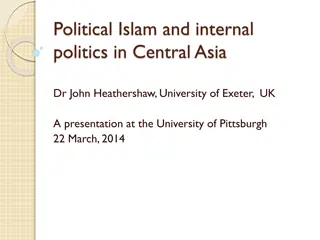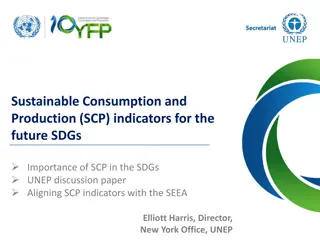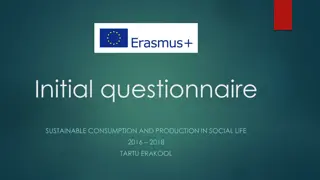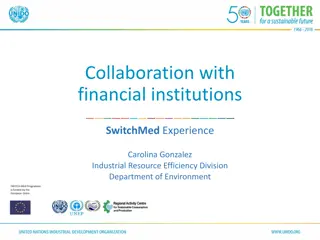Promoting Sustainable Consumption and Production in Asia and Central Asia
This session focuses on the SWITCH-Asia II Programme, aiming to promote sustainable growth, economic prosperity, and poverty reduction in Asia and Central Asia. It addresses the urgent need to decouple economic growth from environmental degradation and supports the transition to a green economy. The programme, launched in 2007, has funded numerous projects to advance sustainable consumption and production practices.
Download Presentation

Please find below an Image/Link to download the presentation.
The content on the website is provided AS IS for your information and personal use only. It may not be sold, licensed, or shared on other websites without obtaining consent from the author. Download presentation by click this link. If you encounter any issues during the download, it is possible that the publisher has removed the file from their server.
E N D
Presentation Transcript
SWITCH-Asia II Promoting Sustainable Consumption and Production (SCP) in Asia and Central Asia The information session will start at 09:30 Brussels time All questions related to this call for proposals can be sent to EuropeAid-SWITCH-ASIA@ec.europa.eu
Information session - Agenda 1. Overview of SWITCH Asia programme 2. Call for proposals: main information (objectives, priorities, target groups, geographical coverage, duration, type of activity, etc.) 3. Call for proposals: finance and contracts rules (eligibility criteria, costs, submission rules, etc.) 4. How to apply and procedures to follow 5. Indicative calendar
1. Overview of SWITCH Asia programme
Regional Indicative Programme (RIP) Asia 2014-2020 Priority sectors TOTAL: EUR 889,5 million Sectors Budget Allocation as percentage 49% Programmes/Actions Promotion of Green Economy EUR 440,5 million SWITCH-Asia, FLEGT, green investment through blending (Asia Investment Facility) Regional integration EUR 320 million 36% Support to ASEAN regional integration, Mekong River area, Trade-related assistance to non- ASEAN countries and other sub- regional programmes Aid to Uprooted people EUR 122 million 14% Support measures EUR 7 million 1% 4
SWITCH ASIA Programme BACKGROUND Many developing countries in Asia and Central Asia find themselves in the midst of a rapid industrial transformation (the fastest growing source of new greenhouse gas emissions in the world) Need to decouple economic growth from the environmental degradation and natural resources depletion Several countries are among the most vulnerable to climate change and natural disasters
SWITCH ASIA Programme MAIN OBJECTIVES OF THE PROGRAMME promote inclusive sustainable growth contribute to the economic prosperity and povertyreduction in Asia and Central Asia PROGRAMME S MAIN FIGURES support the development of a green economy and the transition towards a low-carbon, resource-efficient and circular economy in the 24 target countries Launched in 2007 7 calls for proposal (2007-2016) 110 projects funded (EUR 230 million) Project duration: 36-48 months Average grant size: EUR 1,5 million MAIN OUTPUTS It funded 400 non-for-profit partners, 100 private sector associates, benefitting up to 70.000 Asian MSMEs Adoption of sustainable consumption and production practices, particular among MSMEs to be replicated at higher scale Strengthen the regulatory framework and business related environment Since 2018, it covers 24 countries (extension to Central Asian countries of Tajikistan, Turkmenistan, Kyrgyzstan, Uzbekistan and Kazakhstan) Build capacities for implementing SCP and enhance policy dialogue at national and regional level Increase the interaction between MSMEs and financial intermediaries (access to finance)
SWITCH-Asia II Components Regional Policy Advocacy Component (targeting policy-makers) SCP Facility (general coordination of the 3 components) Grants - (pilot) projects (testing innovative approaches to SCP) Since 2018
2. Call for proposals (EuropeAid 161614): main information
Details on 2019 Call for Proposals 1. Priorities 2. Lots new! 3. Target groups 4. Sectors new! 5. Duration and size of grants 6. Partnership composition 7. Type of actions
Priorities Projects should address at least one or more of these priorities Priority 1: address sustainable supply chains management with a focus on green trade and on facilitating the integration of MSMEs into supply chains. Priority 2: support sustainable consumption and consumer awareness on SCP. Priority 3: focus on either large industrial parks and large economic zones or clusters of SMEs in order to produce bankable projects.
Priorities - specificities Projects in priority 1 and priority 3 should provide: a clear analysisof constraints encountered in terms of access to finance concrete solutions and activities to facilitate the access to finance to support SCP Additional information is provided at page 15 of the guidelines.
New - Lots Projects should be made for one of the 2 geographical lots. Multi-countries proposals are allowed only with countries belonging to the same Lot. Examples of Multi-countries proposals Afghanistan + Uzbekistan is NOT ELIGIBLE! (Lot1+Lot2) Afghanistan + Pakistan is ELIGIBLE (LOT 1). Uzbekistan + Tajikistan is ELIGIBLE (LOT 2).
New Lots: budget allocation EUR 32 700 000 EUR 13 000 000
Target Groups - - - Micro, Small and Medium-Sized Enterprises (MSMEs) Large companies are not identified as beneficiaries of the programme, but engagement with them (e.g. retailers committed to sustainable sourcing) is encouraged. - - Consumer organisations and consumer groups - Business intermediaries and service providers (e.g. industry associations, chambers of commerce, clusters, organisations/ associations of MSMEs, retailers, financial institutions, research centres, etc.) - - - Trade federations and workers associations - - Not-for-profit organisations - - Governmental institutions, local authorities and government- sponsored entities (providing support services to MSMEs and/or responsible for policy and regulatory frameworks on SCP and industrial policies) - -
New - Sectors Proposals should fall under the following SCP General sectors . General sectors Examples of sub-sectors (not exhaustive!) Agri-food processing processing and production of agri-food/beverages/fish and aquaculture, bamboo processing, etc. Building and construction new green materials for constructions, bamboo and traditional bricks processing for constructions/furniture, etc. Digital economy blockchain and/or new technologies for energy production and consumption and for consumer engagement, etc. Energy energy efficiency, renewable energy linked to manufacturing, biofuels, bio-energy, etc. Manufacturing textile and leather, electronics and electrical equipment, machinery, automotive, handicrafts and cottage industries, etc. Plastics product design, processing, etc. Sustainable Tourism development of ecotourism business models, etc. Green trade promotion trade of green products, etc. Transports and logistics public/private green transports in urban areas, green freight transports, reduction of environmental impact of warehousing, new technologies for packaging/delivery processes, e-commerce, etc. Waste management the whole treatment/proceeding of products from collection to recycling, etc. Wood processing timber and rubber processing, etc. Mining processing (this sector only applies to Lot 2 Central Asia)
New - Sectors However, actions targeting Specific priority sectors in-country will receive higher score during the evaluation. The list of sectors by countries is available at page 7 of the guidelines!
New - Sectors The programme is about improving the production processing/methods and not about the primary production or raw- materials!
Duration and size of grants Duration of the project: 36-48 months Size of grants: EUR 1-3 million Total eligible costs of the action: Minimum: 50% of the total eligible costs of the action Maximum: 80% of the total eligible costs of the action (90% for actions taking place in Least Developed Countries-LDC) LDC = Afghanistan, Bangladesh, Bhutan, Cambodia, Laos, Myanmar and Nepal.
Partnership composition (1) Each proposal should be submitted by a partnership composed at least by one lead applicant and one co-applicant. The partnership has to include: at least one organisation from a Member State of the European Union / European Economic Area or an international organisation AND at least one organisation from an eligible Asian or Central Asian country belonging either to Lot 1 or to Lot 2. Attention: for Asian and Central Asian organisations the action should take place only in the country in which the organisation if registered. Example: an organisation registered in Sri Lanka cannot implement an action in India but only in Sri Lanka itself!
Partnership composition (2) Reminder: Multi-countries proposals are possible as long as the countries belong to the same Lot! EXAMPLES Afghanistan + Uzbekistan is NOT ELIGIBLE! (Lot1+Lot2) Afghanistan + Pakistan is ELIGIBLE (LOT 1). Uzbekistan + Tajikistan is ELIGIBLE (LOT 2).
Partnership composition (3) The role of each partnership member organisation must be clearly explained in the proposal. Even though the contracting authority concludes a contract with the lead applicant, the co-applicant(s)/affiliated entities should be shown to actively contribute to the implementation of the project. It is strongly recommended that the applicant and its co-applicant(s) draw up an agreement defining the technical and financial rights and obligations of each partnership member. A clear written allocation of responsibilities and a balanced distribution of costs will contribute to the partnership s success.
Type of action Envisage replication mechanisms Build upon existing capacity and best practices developed in the past (by the programme) Go beyond preparatory activities (studies, etc.) Test new approaches!
Type of activities Examples Research and design of products with lower environmental impact in the entire life cycle (including use and end-of-life stage) Greening the public procurement Promoting eco-labelling schemes Greening the supply-chain Introducing technical innovation and/or facilitating MSMEs funding for SCP- related innovations Improved resourceefficiency (materials, water, energy) Reducing the environmental impact of warehousing Work with retailers Promoting sustainable e-commerce Marketing of environmentally friendly products Re-use, repair and recycle systems Promotion of wastetreatment by consumers Consumer awareness raising and promoting sustainable behaviours Additional information at page 15 of the guidelines.
Type of action Ineligible actions - actions concerned only or mainly with individual sponsorships for participation in workshops, seminars, conferences and congresses - actions concerned only or mainly with individual scholarships for studies or training courses - proposals focusing on primary production or raw materials
3. Call for proposals: finance and contracts rules
Eligibility criteria For both Lead applicant and Co-applicant be a legal person and be non-profit-makingor be a business and for-profit organisation, a consumer organisation, a research centre, a development organisation, a labour organisation or be a non-governmental organisation, public sector operator, local authority, international (inter-governmental) organisation be directly responsible for the preparation and management of the action with the co-applicant(s) and affiliated entity(ies), not acting as an intermediary.
Eligibility criteria For both Lead applicant and Co-applicant Should be established in: a Member State of the European Union or a Member State of the European Economic Area or in countries from the Instrument for Pre-accession Assistance or in member countries of the OECD or in countries belonging to Lot 1 or Lot 2 of this call for proposals
Co-applicants / affiliated entities Co-applicants must satisfy the eligibility criteria as applicable to the lead applicant himself. Co-applicants must sign the mandate in Annex A.2 Section 5 of the grant application form. Only entities having a structural link (e.g. legal or capital link) with the lead applicant and/or to co-applicant(s) may be considered as affiliated entities. However, this link should not be established for the sole purpose of its implementation! Additional information can be found at pages 11-13 of the guidelines.
Number of applications and grants per applicants / affiliated entities Lead applicant Co-applicant/affiliated entity may submit more than 1 application per lot (as a lead applicant) may be the co-applicant or affiliated entity in more than 1 application per lot may notbeawarded more than 1 grant per lot may be awarded more than 1 grant per lot may be a co-applicant or an affiliated entity in another application of the same lot at the same time
Associates and contractors Associates Other organisations or individuals may be involved in the action. Such associates play a real role in the action but may not receive funding from the grant, with the exception of per diem or travel costs. Contractors The beneficiaries and their affiliated entities are permitted to award contracts. Associates or affiliated entity(ies) cannot be also contractors in the project. Contractors are subject to the specific procurement rules (Annex IV).
Eligibility of costs (1) The applicants should provide a realistic and cost-effective budget. The reimbursement of eligible costs may be based on any or a combination of the following forms: actual costs incurred by the beneficiary(ies) and affiliated entity(ies); one or more simplified cost options. Simplified cost options (SCO) may take the form of: unit costs: covering all or certain specific categories of eligible costs which are clearly identified in advance by reference to an amount per unit. lump sums: covering in global terms all or certain specific categories of eligible costs which are clearly identified in advance. flat-rate financing: covering specific categories of eligible costs which are clearly identified in advance by applying a percentage fixed ex ante. Additional information can be found at pages 16-19 of the guidelines.
Eligibility of costs (2) Indirect costs The indirect costs incurred in carrying out the action may be eligible for flat-rate funding, but the total must not exceed 7 % of the estimated total eligible direct costs. Indirect costs are eligible provided that they do not include costs assigned to another budget heading in the standard grant contract. Contributions in kind Contributions in kind are not eligible for this call for proposals Additional information can be found at pages 16-19 of the guidelines.
Ineligible costs debts and debt service charges (interest) provisions for losses or potential future liabilities currency exchange losses credit to third parties salary costs of the personnel of national administrations costs declared by the beneficiary(ies) and financed by another action or work programme receiving a European Union grant Additional information can be found at pages 16-19 of the guidelines.
4. How to apply and procedures to follow
Submission Each applicant s organisation has to be registered into PADOR. For lead-applicants: already at the Concept Note step For co-applicant(s) and affiliated entity(ies): at the full- application stage. The submission of the proposal is done electronically via the IT tool PROSPECT. How to apply in PROSPECT? Go to the Europeaid website Search for the call for proposals (no. 161614) Connect to PROSPECT click on "Apply" Log in with your ECAS username and password
Tips & Tricks Stable internet connection Recommanded to use Internet explorer, Chrome and Firefox You can always save your work as draft Preparation: e-learning and manuals Do not wait until the last minute to apply (deadline to respect)
3 Main steps of evaluation STEP 1: Evaluation of the Concept Note STEP 2: Evaluation of the Full Application STEP 3: Verification of eligibility of the applicants and affiliated entity(ies)
Concept Note application stage Applicants must apply in English The application must be dove via PROSPECT Lead applicants must only provide an estimate of the requested EU contribution as well as an indicative percentage of that contribution in relation to the eligible costs of the action (detailed budget requested only at the full application stage). ATTENTION: the elements outlined in the concept note may not be modified in the full application. The EU contribution may not vary from the initial estimate by more than 20%.
Concept Note evaluation stage New criteria Balanced coverage In order to ensure equal country distribution in each lot, the selection of the proposals at the concept note stage, will be done as the following: Provided that the proposal will meet the criteria of section 2.3 (step 1) and pass the threshold score one application per country will be invited to submit the full application. The rest of the ranking will be done by quality only and not by target country. In case of multi-countries projects, the candidates must clearly specify, in the concept note, which is the principal country where the project will be implemented. To the full application stage will be invited a number of proposal corrisponding to 200% of the available budget for this call for proposals.
Concept Note Evaluation grids Maximum Score 20 Section 1. Relevance of the action 5 1.1. How relevant is the proposal to the objectives and priorities of the call for proposals and to the specific themes/sectors/areas or any other specific requirement stated in the guidelines for applicants? Are the expected results of the action aligned with the priorities defined in the guidelines for applicants (section 1.2)? 5 1.2. How relevant is the proposal to the particular needs and constraints of the target country(ies), region(s) and/or relevant sectors (including synergy with other development initiatives and avoidance of duplication)? 5 1.3. How clearly defined and strategically chosen are those involved (final beneficiaries, target groups)? Have their needs (as rights holders and/or duty bearers) and constraints been clearly defined and does the proposal address them appropriately? 5 1.4. Does the proposal contain particular added-value elements (e.g. innovation, best practices) ? and the other additional elements indicated under 1.2. of the guidelines for applicants? 30 2. Design of the action 10 2.1. How coherent is the overall design of the action? Does the proposal indicate the expected results to be achieved by the action? Does the intervention logic explain the rationale to achieve the expected results? 2.2. Does the design reflect a robust analysis of the problems involved, and the capacities of the relevant stakeholders? 5 2.3. Does the design take into account external factors (risks and assumptions)? 5 5 2.4. Are the activities feasible and consistent in relation to the expected results (including timeframe)? Are results (output, outcome and impact) realistic? 5 2.5. To which extent does the proposal integrate relevant cross-cutting elements such as environmental/climate change issues, promotion of gender equality and equal opportunities, needs of disabled people, rights of minorities and rights of indigenous peoples, youth, combating HIV/AIDS (if there is a strong prevalence in the target country/region)? 50 Maximum total score
Full Application Evaluation grids Maximum Score Section 1. Financial and operational capacity 20 2. Relevance of the action* 20 3. Design of the action* 15 4. Implementation approach 15 5. Sustainability of the action 15 6. Budget and cost-effectiveness of the action 15 Maximum total score 100
CALL FOR PROPOSALPUBLICATION 11 January 2019 PRE INFORMATION MEETING 17 January 2019 DEADLINE FOR POSING QUESTIONS (Concept Note) 7 February 2019 FAQ PUBLICATION: LATEST ANSWERS TO THE QUESTIONS 17 February 2019 Questions related to this call for proposals should be sent ONLY to the following mail address: EuropeAid-SWITCH-ASIA@ec.europa.eu
DEADLINE FOR SENDING CONCEPT NOTES 28 February 2019 (12:00 Brussels time) OPENING AND ADMINISTRATIVE CHECK & TECHNICAL EVALUATION OF THE CONCEPT NOTES March 2019 COMMUNICATION OF THE RESULTS TO ALL APPLICANTS/ invitation to submit full application April/May 2019
DEADLINE FOR SENDING FULL APPLICATIONS June/July 2019 DEADLINE FOR POSING QUESTIONS (Full Application) Until 21 days before the deadline FAQ PUBLICATION: ANSWERS TO THE QUESTIONS Until 11 days before the deadline EVALUATION OF FULL APPLICATIONS & COMMUNICATION TO ALL THE APPLICANTS July/August 2019 VERIFICATION OF ELIGIBILITY (applicant and partners) & NOTIFICATION TO SUCCESSFUL APPLICANTS July/August 2019 NOTIFICATION OF THE AWARD (after eligibility check) September/October 2019 CONTRACT SIGNATURE October/November 2019
Multi-beneficiary grant contract AllthesignatoryLEFsare enteredinthe system. Co-applicant 1 Mandate CONTRACTis signedbyallthe beneficiaries LeadApplicant Mandate Co-applicant 2
Multi-beneficiary grant contract = Contract signed by several beneficiaries Lead applicant / Coordinator: - Plays the role of "lead applicant" / "main beneficiary" - Gets a mandate from the rest of co-applicant(s): To submit the proposal To sign the contract To represent the rest during implementation of the contract - Assumes the financial responsibility of the contract
Multi-beneficiary grant contract with affiliated entities Note : Applicants and Beneficiaries may (or not) have affiliated entities, butthese never signthecontract. AllthesignatoryLEFsare entered inthe system. Co-applicant 1 AffiliatedEntity1 CONTRACTis signedbyallthe beneficiaries AffiliatedEntity2 LeadApplicant Co-applicant 2 AffiliatedEntity3
APPLICANTS SHOULD ALWAYS Read carefully the guidelines Submit your proposal on time via prospect Submit a good technical proposal Submit a correct and detailed budget Fill in all data in PADOR
APPLICANTS SHOULD ALWAYS Check carefully their eligibility (including co-applicants/ affiliated entities) Get their co-applicants/affiliated entities and themselves registered in Pador in time (legal documents uploaded, etc.) Check regularly Europe aid website (FAQ, corrigendum, etc.)



